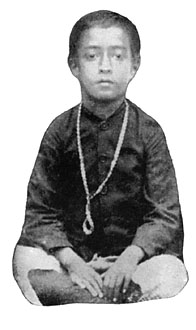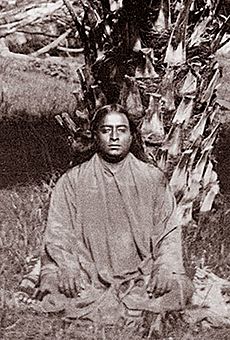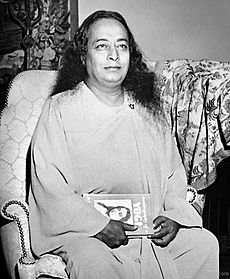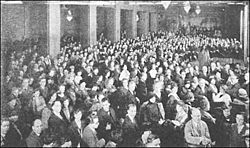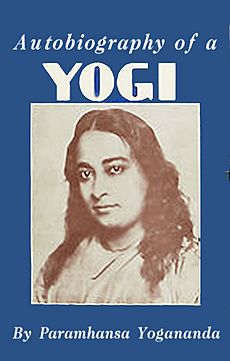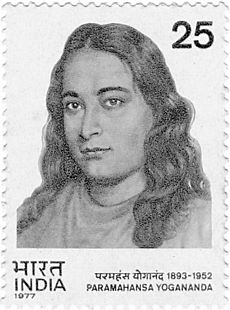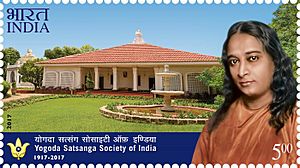Paramahansa Yogananda facts for kids
Quick facts for kids Paramahansa Yogananda |
|
|---|---|
 |
|
| Birth Date | January 5, 1893 Gorakhpur, North-Western Provinces, British India (now in Uttar Pradesh, India) |
| Died on | March 7, 1952 (aged 59) Biltmore Hotel, Los Angeles, California, United States |
| Birth name | Mukunda Lal Ghosh |
| Guru/teacher | Swami Sri Yukteswar Giri |
| Philosophy | Kriya Yoga |
Paramahansa Yogananda (born Mukunda Lal Ghosh; January 5, 1893 – March 7, 1952) was an Indian Hindu monk and yogi. He was a spiritual teacher, known as a guru, who taught millions about meditation and Kriya Yoga. He did this through his organizations, Self-Realization Fellowship (SRF) and Yogoda Satsanga Society (YSS) of India. He spent the last 32 years of his life in America.
Yogananda was a main student of the yoga guru Swami Sri Yukteswar Giri. His teachers sent him to share yoga in the West. He aimed to show how Eastern and Western religions are connected. He also wanted to teach a balance between Western focus on money and Indian spirituality. Many experts call him the "Father of Yoga in the West." This is because of his big impact on yoga in America, especially in Los Angeles.
Yogananda was the first major Indian teacher to live in America. He was also the first important Indian person to be invited to the White House. This happened in 1927 with President Calvin Coolidge. The Los Angeles Times called him "the 20th century's first superstar guru." He arrived in Boston in 1920 and gave many popular talks across the country. In 1925, he settled in Los Angeles.
For over 25 years, he became well-known and spread his influence worldwide. He started a group of monks and trained students. He also went on teaching tours and bought properties for his organization in California. Thousands of people learned Kriya Yoga from him. By 1952, SRF had over 100 centers in India and the US. Today, they have groups in almost every major American city. His ideas of "plain living and high thinking" attracted people from all walks of life.
In 1946, he published his book, Autobiography of a Yogi. It was very popular and sold over four million copies. Harper San Francisco listed it as one of the "100 best spiritual books of the 20th Century." Apple CEO Steve Jobs ordered 500 copies for his own memorial. Each guest received a copy. The book is known as "the book that changed the lives of millions." A movie about his life, Awake: The Life of Yogananda, came out in 2014. He is still a very important figure in Western spirituality today.
Contents
Paramahansa Yogananda's Early Life and Training
Growing Up and Finding a Teacher
Yogananda was born in Gorakhpur, Uttar Pradesh, India. His family was Hindu and Bengali. He was the fourth of eight children. His father, Bhagabati Charan Ghosh, was a Vice President of the Bengal Nagpur Railway. His mother was Gyanprabha Devi. His younger brother, Sananda, said that young Mukunda (Yogananda's birth name) had a special spiritual awareness from a very young age.
Because his father worked for the railway, his family moved many times. They lived in places like Lahore, Bareilly, and Kolkata. When he was eleven, his mother passed away. She left him a special amulet given to her by a holy man. This man said Mukunda would have it for some years, then it would disappear.
As a child, his father often gave him train passes. He used them to visit distant cities and holy places with friends. In his youth, he looked for many wise Indian teachers. He hoped to find someone to guide him on his spiritual journey.
After high school, Yogananda left home to join a spiritual community in Varanasi. But he soon felt it focused too much on organization, not enough on meditation. He prayed for guidance. In 1910, at age 17, he met his true teacher, Swami Sri Yukteswar Giri. At that moment, his special amulet mysteriously disappeared.
He trained with Sri Yukteswar for ten years, from 1910 to 1920. This training happened at hermitages in Serampore and Puri. Later, Sri Yukteswar told Yogananda that a great guru, Mahavatar Babaji, had sent him. His mission was to spread yoga around the world.
In 1915, he earned a degree from Serampore College. This allowed him to spend time at Yukteswar's spiritual center. In July 1915, he became a monk in the Swami order. Sri Yukteswar let him choose his own name: Swami Yogananda Giri.
In 1917, Yogananda started a school for boys in Dihika, West Bengal. It mixed modern education with yoga and spiritual ideas. A year later, the school moved to Ranchi. His youngest brother, Bishnu Charan Ghosh, was one of the first students. This school later became the Yogoda Satsanga Society of India. This is the Indian part of Yogananda's American organization, Self-Realization Fellowship.
Sharing Yoga in America
Coming to the West
In 1920, while meditating at his Ranchi school, Yogananda had a vision. He saw many American faces, which told him he would soon go to America. He then went to Calcutta. The next day, he received an invitation. The American Unitarian Association asked him to represent India at a religious meeting in Boston.
He asked his teacher, Sri Yukteswar, for advice. Sri Yukteswar told him to go. According to Yogananda's book, Autobiography of a Yogi, he also had a special visit. Mahavatar Babaji, the Great Guru of his spiritual family, appeared to him. Babaji told him directly that he was chosen to bring Kriya Yoga to the West. Feeling sure and inspired, Yogananda accepted the offer to go to Boston.
In August 1920, he sailed to the United States. The journey took two months, and he arrived near Boston in late September. He spoke at the International Congress in early October, and people liked his message. Later that year, he started the Self-Realization Fellowship (SRF). Its goal was to share his teachings on India's ancient yoga and meditation practices worldwide.
Yogananda spent the next four years in Boston. He gave talks and taught on the East Coast. In 1924, he went on a speaking tour across the country. Thousands of people came to hear him. During this time, he attracted famous followers. These included singer Amelita Galli-Curci and Clara Clemens Gabrilowitsch, who was the daughter of Mark Twain.
In 1925, he opened an international center for Self-Realization Fellowship in Los Angeles, California. This became the main spiritual and administrative hub for his growing work. Yogananda was the first Hindu yoga teacher to spend most of his life in America. He lived in the United States from 1920 to 1952. He took one long trip abroad in 1935–1936. Through his students, he created many Kriya Yoga centers around the world.
During this time, some authorities watched Yogananda. This was due to general concerns about new spiritual movements and the independence movement in India. There were some challenges, but Yogananda continued his work.
Journey Back to India (1935–1936)
In 1935, Yogananda sailed back to India. Two of his Western students came with him. He wanted to visit his teacher, Sri Yukteswar Giri. He also wanted to help set up his Yogoda Satsanga work in India. On the way, his ship stopped in Europe and the Middle East. He visited spiritual places like Assisi, Italy (to honor St. Francis), ancient Greek temples, and the Holy Land of Palestine. He also saw the ancient Pyramids in Cairo, Egypt.
In August 1935, he arrived in Mumbai, India. Because he was famous in America, many photographers and journalists met him. He then took a train to Kolkata. A huge crowd and a special parade, led by his brother, Bishnu Charan Ghosh, met him there. He had a very emotional reunion with his teacher, Sri Yukteswar, in Serampore.
During his stay in India, his Ranchi boys' school became officially recognized. He also took a group to visit famous places. These included the Taj Mahal in Agra, the Chamundeshwari Temple in Mysore, and the Kumbh Mela festival in Allahabad.
He met many interesting people, too. He met Mahatma Gandhi and taught him Kriya Yoga. He also met the woman-saint Anandamoyi Ma. He saw Giri Bala, an elderly yogi who lived without eating. He also met famous scientist Chandrasekhara Venkata Raman. While in India, Sri Yukteswar gave Yogananda a new spiritual title, Paramahansa. This means "supreme swan" and shows the highest spiritual achievement.
In March 1936, Sri Yukteswar passed away in Puri. After his teacher's funeral, Yogananda continued to teach and meet with people for several months. He then planned to return to the US in mid-1936.
According to his autobiography, in June 1936, Yogananda had a special experience. He saw the spirit of his teacher, Sri Yukteswar, who had returned. This happened in a hotel room in Mumbai. During this experience, Sri Yukteswar explained many deep truths about the spiritual world. He talked about life after death and how our actions affect us. With new wisdom, Yogananda and his two students left India. They stayed in England for several weeks, teaching yoga classes in London, before heading to the US in October 1936.
Final Years in America and Passing
Returning to California
In late 1936, Yogananda's ship arrived in New York. He then drove across the US back to his headquarters in Mount Washington, California. He continued to give talks, write, and open churches in southern California. He lived at the SRF hermitage in Encinitas, California. This was a gift from his student Rajarsi Janakananda. At this hermitage, Yogananda wrote his famous Autobiography of a Yogi and other books. He also created a strong foundation for the work of Self-Realization Fellowship.
In 1946, Yogananda applied for US citizenship. His application was approved in 1949, and he became a naturalized citizen. The last four years of his life were spent mostly away from public view. He was with a small group of students at his desert retreat in Twentynine Palms, California. There, he finished his writings and revised his books and lessons. During this time, he gave few public talks. He told his students, "I can do much more now to reach others with my pen."
His Passing
Yogananda began to hint to his students that his time on Earth was ending. On March 7, 1952, he attended a dinner for the Indian Ambassador to the U.S. at the Biltmore Hotel in Los Angeles. At the end of the dinner, Yogananda spoke about India and America. He talked about their roles in world peace and progress. He hoped for a "United World" that would combine the best of "efficient America" and "spiritual India."
According to his student Daya Mata, who was there, Yogananda ended his speech by reading from his poem My India. He finished with the words, "Where Ganges, woods, Himalayan caves, and men dream God—I am hallowed; my body touched that sod." Daya Mata said that as he spoke these words, he looked up, and his body gently fell to the floor.
His funeral service was held at the SRF headquarters in Los Angeles. Hundreds of people attended. Rajarsi Janakananda, whom Yogananda chose to lead Self-Realization Fellowship next, performed a special ceremony.
A unique thing happened after his passing. For three weeks, Yogananda's body showed no signs of decay. His face looked peaceful and unchanged. The mortuary director, Harry T. Rowe, wrote a letter about it. He said that this perfect preservation was "unparalleled" in their experience. He noted that no smell of decay came from his body at any time. This was considered a very unusual event. Yogananda's remains are buried at the Forest Lawn Memorial Park in Glendale, California. Doctors said his death was due to a heart attack. His followers believe he consciously left his body, a yogic practice called mahasamadhi.
Yogananda's Teachings
Core Ideas and Spiritual Practices
In 1917, Yogananda started his life's work in India. He founded a "how-to-live" school for boys. This school mixed modern education with yoga training and spiritual ideas. In 1920, he was invited to speak in Boston. His talk, "The Science of Religion," was very well received. For several years after that, he lectured and taught across the United States.
His talks explained the "unity of 'the original teachings of Jesus Christ and the original Yoga taught by Bhagavan Krishna.'" In 1920, he founded the Self-Realization Fellowship. In 1925, he set up its international headquarters in Los Angeles, California.
Yogananda wrote books like The Second Coming of Christ: The Resurrection of the Christ Within You and God Talks With Arjuna – The Bhagavad Gita. In these books, he explained his belief that original Christianity and original Yoga share the same truths. He taught that these principles are the common scientific basis of all true religions.
In his published work, The Self-Realization Fellowship Lessons, Yogananda gives detailed instructions. These are for practicing the highest yoga science of knowing God. This ancient science includes the specific principles and meditation techniques of Kriya Yoga. Yogananda taught his students that they needed to experience truth directly, not just believe blindly. He said, "The true basis of religion is not belief, but intuitive experience. Intuition is the soul's power of knowing God. To know what religion is really all about, one must know God."
Following traditional Hindu teachings, he taught that the whole universe is like God's cosmic movie. He said that people are just actors in this divine play. We change roles through reincarnation. He taught that human suffering comes from identifying too much with our current role. Instead, we should remember we are part of the movie's director, or God.
In his book, How you can talk with God, he says anyone can talk with God. This happens if a person keeps trying with strong devotion. He also said that God had spoken to him many times. He claimed that miracles happened in his life because of this. In the book, he says, "When our heart-call is intense, and we do not give up, God will come."
Understanding Kriya Yoga
The "science" of Kriya Yoga is a main part of Yogananda's teachings. It is an ancient spiritual practice. Kriya Yoga means "union (yoga) with the Infinite through a certain action or rite (kriya)." The Sanskrit word kriya means "to do, to act and react."
Kriya Yoga was passed down through Yogananda's spiritual family. Mahavatar Babaji taught the Kriya technique to Lahiri Mahasaya. Lahiri Mahasaya then taught it to his student, Swami Sri Yukteswar Giri, who was Yogananda's teacher.
Sri Mrinalini Mata, a former leader of SRF/YSS, said, "Kriya Yoga is so effective, so complete, because it brings God's love... into operation in the devotee's life." Yogananda wrote in Autobiography of a Yogi that the "actual technique should be learned from an authorized Kriyaban (Kriya Yogi) of Self-Realization Fellowship /Yogoda Satsanga Society of India."
Autobiography of a Yogi
In 1946, Yogananda published his life story, Autobiography of a Yogi. It has been translated into 45 languages. In 1999, a group of spiritual authors called it one of the "100 Most Important Spiritual Books of the 20th Century." Autobiography of a Yogi is the most popular of Yogananda's books.
According to Philip Goldberg, who wrote American Veda, the Self-Realization Fellowship is right to say, "The Book that Changed the Lives of Millions." It has sold over four million copies and continues to sell. In 2006, the publisher, Self-Realization Fellowship, celebrated the book's 60th anniversary. They did this with projects to promote Yogananda's legacy.
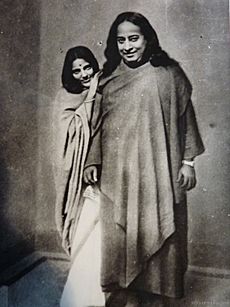
Autobiography of a Yogi describes Yogananda's spiritual journey to find enlightenment. It also tells about his meetings with important spiritual figures. These include Therese Neumann, Anandamoyi Ma, Mohandas Gandhi, and Nobel Prize winner Rabindranath Tagore. He also met famous scientists like Luther Burbank, Sir Jagadish Chandra Bose, and Sir C. V. Raman. One important chapter, "The Law of Miracles," gives scientific explanations for seemingly impossible feats. He writes: "the word 'impossible' is becoming less prominent in man's vocabulary."
The Autobiography has inspired many people. These include musician George Harrison, sitar player Ravi Shankar, and Apple co-founder Steve Jobs. In the 2011 book Steve Jobs: A Biography, the author writes that Jobs first read the Autobiography as a teenager. He re-read it in India and later read it every year. Jon Anderson was inspired by Yogananda and his book when he wrote Tales From Topographic Oceans. The captain of the India national cricket team, Virat Kohli, said the Autobiography positively influenced his life and urged everyone to read it.
Claims of Bodily Preservation
After Yogananda's death, his body showed a remarkable lack of decay for three weeks. Harry T. Rowe, the mortuary director, wrote a notarized letter about this. He stated that the absence of any visual signs of decay was "the most extraordinary case in our experience." He also said, "This state of perfect preservation of a body is, so far as we know from mortuary annals, an unparalleled one."
Rowe noted that Yogananda's body was embalmed about 24 hours after his death. However, even with embalming, such a long period without visible decay is highly unusual. On March 27th, twenty days after his passing, Rowe observed that Yogananda's body looked as fresh and untouched by decay as it had on the day of his death. He concluded that "the case of Paramahansa Yogananda is unique in our experience."
Self-Realization Fellowship published Rowe's letter in their magazine and in a booklet. Yogananda's crypt is located in the Great Mausoleum at Forest Lawn Memorial Park in Glendale, California.
Yogananda's Legacy
Self-Realization Fellowship and Yogoda Satsanga Society
The Yogoda Satsanga Society of India (YSS) is a non-profit religious organization. Yogananda founded it in 1917. Outside of India, it is known as the Self-Realization Fellowship (SRF). Yogananda's teachings are continued through these organizations. He founded YSS in India in 1917 and then expanded it to the United States in 1920, calling it Self-Realization Fellowship. In 1935, he officially made it a legal organization in the U.S. This was to help preserve and spread his teachings worldwide.
SRF/YSS has its main office in Los Angeles. It has grown to include over 500 temples and centers around the world. It has members in more than 175 countries, including the Self-Realization Fellowship Lake Shrine. In India and nearby countries, YSS spreads Yogananda's teachings. It has over 100 centers, retreats, and ashrams.
Rajarsi Janakananda was chosen by Yogananda to become the President of SRF/YSS after him. Daya Mata, a religious leader and a direct student of Yogananda, led SRF/YSS from 1955 to 2010. She was personally chosen and trained by Yogananda. Later, Mrinalini Mata, another direct student, became president from 2011 until her passing in 2017. She was also chosen by Yogananda. On August 30, 2017, Brother Chidananda was elected as the next president. Yogananda made Self-Realization Fellowship a non-profit organization. He transferred all his property, including Mt. Washington, to the organization. This helped protect its assets for the future.
On November 15, 2017, the President of India, Ram Nath Kovind, visited the Yogoda Satsanga Society of India's Ranchi Ashram. This was for its 100th anniversary. It was also to celebrate the release of the Hindi translation of Yogananda's book God Talks with Arjuna: The Bhagavad Gita.
Special Stamps Honoring Yogananda
India released a special stamp in honor of Yogananda in 1977. The Department of Post issued this stamp to mark 25 years since Yogananda's passing. It honored his great contributions to helping humanity spiritually. The stamp recognized his "ideal of love for God and service to humanity." It stated that "Though the major part of his life was spent outside India, still he takes his place among our great saints."
On March 7, 2017, the Prime Minister of India, Narendra Modi, released another special stamp. This one honored the 100th anniversary of the Yogoda Satsanga Society of India. Prime Minister Modi praised Yogananda for sharing India's spirituality in other countries. He said that even though Yogananda left India to spread his message, he always stayed connected to his home country.
Images for kids
See also
 In Spanish: Paramahansa Yogananda para niños
In Spanish: Paramahansa Yogananda para niños
- List of Hindu gurus and saints
- Paramahamsa


